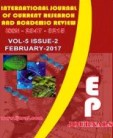Abstract Volume:5 Issue-2 Year-2017 Original Research Articles
 |
Online ISSN : 2347 - 3215 Issues : 12 per year Publisher : Excellent Publishers Email : editorijcret@gmail.com |
2Department of Biotechnology, Pillai’s College, Panvel, Navi Mumbai, India
In the present study, the edible fungus Pleurotus sajor-caju was investigated for its ability to grow on different lignocellulosic substrates namely, water hyacinth, wood chips and paddy and to produce various lignocellulolytic enzymes such as cellulase, xylanase and pectinase. The production pattern of the extracellular enzymes, total proteins and reducing sugar level was studied during the growth of this fungus under Solid State Fermentation (SSF) for a period of 56 days. Wheat grains were rapidly utilized and consumed by the fungus as a simple carbon source and were used for spawn formation. Different lignocellulosic complex carbon sources served as substrates and exhibited better induction process for more enzyme biosynthesis and production. The maximum activity of enzymes was obtained on 28th and 56th day of culture growth. The total yield of mushroom grown on different lignocellulosic substrates and levels of cellulose, pectinase and xylanase was also detected.
How to cite this article:
Rashmi Padhye and Sneha Atawane. 2017. Cultivation of Oyster Mushroom and Recovery of Value Added by- products from Biodegradable Lignocellulosic Waste Materials by Solid State Fermentation.Int.J.Curr.Res.Aca.Rev. 5(2): 34-43doi: http://dx.doi.org/10.20546/ijcrar.2017.502.005



Quick Navigation
- Print Article
- Full Text PDF
- How to Cite this Article
- on Google
- on Google Scholor
- Citation Alert By Google Scholar
